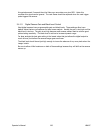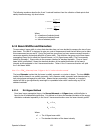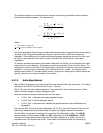equivalent second moment width for TEM
00
beams, and are a good approximation for many beams of
mixed modes.
The second Knife Edge selection will allow you to program your own Clip% and Multiplier values.
This option will allow you to set up for beams requiring special settings, which could get you into all
kinds of trouble, since you can set these values to just about anything you like.
When the LBA’s Elliptical results are disabled, the computed beam widths will be aligned with a pair
of simulated knife-edges cutting one in each of the X and Y directions. Hence, the displayed beam
widths will be indicated in the results window as X and Y. If your laser beam is not radially symmetric
but does contain two axes of symmetry, you should rotate the beam such that the beam's axes align
with the X and Y axes of the display.
When the LBA's Elliptical results are enabled, the computed beam widths will be aligned with a pair
of simulated knife-edges cutting one in each of the Major and Minor axial directions. Hence, the
displayed beam widths will be indicated in the results window as Major and Minor. The implication is
that the displayed values represent the major and minor widths of an elliptically shaped laser beam.
6.11.3 Percent of Energy Method
The LBA measures the lengths of two orthogonal lines that pass through the beam centroid. The
beam widths are determined by separately looking out along each line and count all the pixels that are
greater than the set clip level. The reported beam widths are the number of pixels greater than the
clip level multiplied by the pixel pitch.
When the LBA's Elliptical results are disabled, the computed beam widths are the measure of the
pixels in the row and column that pass through the centroid. The beam widths in the results window
are labeled X and Y.
When the LBA's Elliptical results are enabled, the computed beam widths are the measure of the
pixels along the Major and Minor axes that pass through the centroid. The beam widths in the results
window are labeled Major and Minor.
6.11.4 Percent of Peak Method
The LBA measures the lengths of two orthogonal lines that pass through the beam centroid. The
beam widths are determined by separately looking out along each line and counting all the pixels that
are greater than the set clip level. The reported beam widths are the number of pixels greater than
the clip level multiplied by the pixel pitch.
When the LBA's Elliptical results are disabled, the computed beam widths are the measure of the
pixels in the row and column that pass through the centroid. The beam widths in the results window
are labeled X and Y.
When the LBA's Elliptical results are enabled, the computed beam widths are the measure of the
pixels along the Major and Minor axes that pass through the centroid. The beam widths in the results
window are labeled Major and Minor.
6.12 Elliptical beam
The LBA-PC can compute and display the Orientation of an Elliptical or rectangular beam and a
coefficient of Roundness. The criteria for computing the Elliptical beam's Major and Minor beam
widths are described in the Beam Widths and Diameters section.
Operator’s Manual LBA-PC
134


















